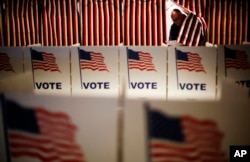The state of New Hampshire is appealing a decision that allows voters to take pictures inside voting booths. It would like to join other U.S. states that have banned any voting booth documentation in the form of digital images or photography being shared on social media or otherwise.
In other words: No selfies with your ballot.
"It's natural that people — particularly young people who are participating in the democratic process —want to make a record of their specific act of casting a ballot," John Hardin Young, Chair of the American Bar Association's Standing Committee on Election Law, told VOA. "That can include taking a photograph with their phone of the actual ballot face as it's marked. In a way, we are really at loggerheads. On the one hand, we want everyone to participate. On the other, we do want to make sure that the ballot box remains secret."
The secret ballot has long been perceived as an integral part of the U.S. democratic system, protecting voters from criticism or peer pressure and allowing them to fulfill their democratic privilege in private.
Many states, such as New Hampshire, believe that documentation of ballots may promote an uptick in voter fraud and buying votes — allowing companies or individuals to force paid voters to give confirmation that they completed their "job."
But a federal judge ruled in 2015 that New Hampshire could not ban photography in the voting booth.
Snapchat gets involved
The social network Snapchat joined the discussion last week by filing a court brief in the New Hampshire case, arguing that engaging in social media is a way of political expression — a millennial's version of an "I Voted" sticker that keeps them involved and excited about the political process.
"Whatever its form, the voter's message is the same: I'm participating in the civic process, and you should, too," Snapchat said. "That message has carried over to the virtual world. Millions of voters announce online that they have voted, and many engage with or share political content with their online networks. Selfies and ballot selfies are part of that."
Snapchat also argued that as a news gatherer, the social media app has a journalistic interest — guaranteed under the first amendment of the Constitution — to share ballot booth selfies.
"The State's ballot-selfie ban unjustifiably infringes on that right," Snapchat said.
Steven LaBonte, a representative for the case from the office of the Attorney General of New Hampshire, does not deny the importance of news gathering and the press's right to freedom of expression. But he did not buy Snapchat's claim that ballot selfies have a place in modern news gathering.
"I think the press has a news gathering duty, but it has been done for years without the ballot selfie," he told VOA.
Snapchat's format has changed and expanded in recent years, moving toward more live "stories" that can be viewed by a broad audience as opposed to sending individual "snaps" to a handpicked list of people, but the basic principle of sending an image that can only be seen once before it disappears remains the same.
Young does not think that Snapchat's format lends itself to the arguments it is making in regard to documentation, but says that, regardless of the nature of the photo, the overarching question remains the same.
What is best for the voting booth?
"Whether that is an instant snap for a moment or all time — the real question is what do you believe is the predominant or best policy for the voting booth?"
Laws vary by state
There is no federal consensus on photography in the voting booth, and laws vary dramatically state by state.
While some states, such as South Carolina, have virtually no restrictions, Pennsylvania voters can face fines of up to $1,000 for posing with their ballot. Many other states, such as Texas, have more moderate policies — they ban cellphones and photographs inside the voting booth, but the offense is not punishable by law.
Young said that while this case is bound to receive national attention, a federal law is unlikely.
"Most of the laws regarding voting are decided at the state level … and I don't see that changing," he said.












